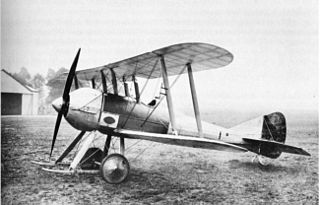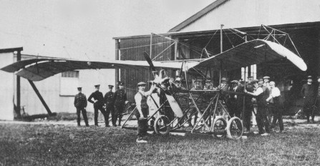
The Royal Aircraft Establishment (RAE) was a British research establishment, known by several different names during its history, that eventually came under the aegis of the UK Ministry of Defence (MoD), before finally losing its identity in mergers with other institutions.

The Royal Aircraft Factory B.E.2 is a British single-engine tractor two-seat biplane, designed and developed at the Royal Aircraft Factory. Most of the roughly 3,500 built were constructed under contract by private companies, including established aircraft manufacturers and firms new to aircraft construction.

The Airco DH.2 was a single-seat pusher biplane fighter aircraft which operated during the First World War. It was the second pusher design by aeronautical engineer Geoffrey de Havilland for Airco, based on his earlier DH.1 two-seater.

Between 1911 and 1914, the Royal Aircraft Factory used the F.E.2 designation for three quite different aircraft that shared only a common "Farman" pusher biplane layout.

The Royal Aircraft Factory F.E.1 was designed and built in 1910 by the pioneer designer Geoffrey de Havilland. He used it to teach himself to fly during late 1910. After De Havilland was appointed assistant designer and test pilot at the Army Balloon Factory at Farnborough in December 1910 the War Office bought the aircraft for £400. the aircraft was given the designation F.E.1

The Royal Aircraft Factory F.E.8 is a British single-seat fighter of the First World War designed at the Royal Aircraft Factory. It could not escape the drag penalty imposed by its tail structure and was no match for the Albatros fighters of late 1916.

The Blériot XII was an early French aeroplane built by Louis Blériot. It was first flown in May 1909 and was the first aircraft to be flown with two passengers on board, and was used by Blériot to gain second place in the 1909 Gordon Bennett Cup and to set a new world speed record.

The British Army Aeroplane No 1 or sometimes Cody 1 was a biplane built by Samuel Franklin Cody in 1907 at the Army Balloon Factory at Farnborough. It made the first recognised powered and sustained flight in the United Kingdom on 16 October 1908.

The Royal Aircraft Factory S.E.2 was an early British single-seat scout aircraft. Designed and built at the Royal Aircraft Factory in 1912–13 as the B.S.1, the prototype was rebuilt several times before serving with the Royal Flying Corps over the Western Front in the early months of the First World War.

The Cody V was a single-engined biplane built by the British-based American aviation pioneer Samuel Franklin Cody in 1912. It was built from the remains of two of Cody's earlier aircraft, and won the 1912 British Military Aeroplane Competition, with two aircraft being purchased for the Royal Flying Corps. The design was abandoned after the mid-air disintegration of one of the aircraft in April 1913.

The Cody IV monoplane was a single-engined monoplane designed and built by the American-born but British-based aviation pioneer Samuel Franklin Cody in 1912. It was intended for entry into the 1912 British Military Aeroplane Competition, but was wrecked in a crash before the start of the competition.

The Dunne D.7 was one of J. W. Dunne's swept wing tailless aircraft designed to have automatic stability, first flying in 1911. It was a single seat, single engined pusher monoplane developed from the unsuccessful D.6.
The Royal Aircraft Factory F.E.3 (also known as the A.E.1 was a British experimental single-engined pusher biplane built prior to the First World War. It was intended to be fitted with a shell-firing gun, but was quickly abandoned, being found to be structurally unsound.
The Royal Aircraft Factory C.E.1 was a prototype British flying boat of the First World War. It was a single-engined pusher configuration biplane intended to carry out coastal patrols to protect shipping against German U-boats, but only two were built, the only flying boats to be designed and built by the Royal Aircraft Factory.

The Short S.27 and its derivative, the Short Improved S.27, were a series of early British aircraft built by Short Brothers. They were used by the Admiralty and Naval Wing of the Royal Flying Corps for training the Royal Navy's first pilots as well as for early naval aviation experiments. An Improved S.27 was used by C.R. Samson to make the first successful take-off from a moving ship on 9 May 1912.
John Kenworthy B.Sc., F.R.Aes (1883–1940) was an English aviation engineer and aircraft designer.

The ASL Valkyrie was a canard pusher configuration aircraft designed by the Aeronautical Syndicate Ltd in 1910. Examples were widely flown during 1911 and were used for instructional purposes at the ASL flying school, which was the first occupant of Hendon Aerodrome in London.

The Cody Michelin Cup Biplane was an experimental aircraft designed and built in Britain during 1910 by Samuel Franklin Cody, a prominent showman and aviation pioneer. Cody had worked with the British Army on experiments with man-lifting kites and in October 1908 had successfully built and flown the British Army Aeroplane No 1, making the first officially verified powered flight in the United Kingdom. Cody broke the existing endurance record twice in the aircraft, the second flight, made on 31 December 1910, winning him the Michelin Cup for the longest-lasting flight made over a closed circuit in the United Kingdom before the end of the year.
The Mersey Monoplane was a prototype two-seat British pusher configuration monoplane of the early 1910s. A single example was built and entered into the 1912 British Military Aeroplane Competition but crashed during the trials and was destroyed.

The pioneer era of aviation was the period of aviation history between the first successful powered flight, generally accepted to have been made by the Wright Brothers on 17 December 1903, and the outbreak of the First World War in August 1914.
















